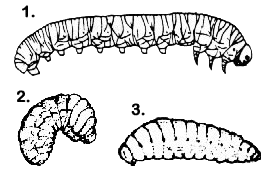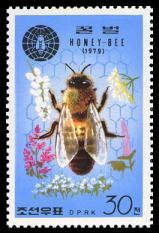Hymenoptera
Pronunciation: [HY·me·NOP·ter·a]
Pronunciation: [HY·me·NOP·ter·a]
Common Name: ants, bees, wasps, and sawflies
Greek Origins of Name: Hymenoptera is derived from the Greek words “hymen” meaning membrane and “ptera” meaning wings. It is also a reference to Hymeno, the Greek god of marriage. The name is appropriate not only for the membranous nature of the wings, but also for the manner in which they are “joined together as one” by the hamuli.
Apidae — Bumble Bees and Honey Bees
Formicidae — Ants
Halictidae — Sweat Bees
Ichneumonidae — Ichneumon Wasps
Sphecidae — Sand Wasps, Digger Wasps, and Mud-daubers
Scoliidae — Scoliid Wasps
Vespidae — Yellowjackets, Hornets, Paper Wasps, and Potter Wasps
Holometabola i.e. complete metamorphosis (egg, larva, pupa, adult)
Two suborders:
1. Symphyta (sawflies and horntails) have a broad junction between thorax and abdomen
2. Apocrita (ants, bees, and wasps) have a narrow junction between the thorax and abdomen
Common worldwide. Third largest order of insects, with approximately 70 families and 18,000 species in North America and 90 families and 153,000 species worldwide
As a rule, members of the order Hymenoptera can be regarded as ecological specialists. Most species are rather narrowly adapted to specific habitats and/or specific hosts. Their remarkable success as a taxon probably has more to do with their immense range of behavioral adaptation rather than any physical or biochemical characteristic. The Hymenoptera is the only order besides the Isoptera (termites) to have evolved complex social systems with division of labor.
Herbivory is common among the primitive Hymenoptera (suborder Symphyta), in the gall wasps (Cynipidae), and in some of the ants and bees. Most other Hymenoptera are predatory or parasitic. The large hunting wasps are agile predators that catch and paralyze insects (or spiders) as food for their offspring. The greatest diversity, though, is found among the many families of parasitoid wasps whose larvae feed internally on the living tissues of other arthropods (or their eggs). These insects eventually kill their host, but not before completing their own larval development within its body. Despite their small size and characteristically narrow host range, these wasps are highly abundant and exert a tremendous impact on the population dynamics of many other insect species.
Most of the Hymenoptera have relatively unspecialized mandibulate mouthparts. An exception is found in the bees (superfamily Apidoidae) where the maxillae and labium are modified into a proboscis that works like a tongue to collect nectar from flowers. In these insects, the mandibles are used to gather or manipulate pollen and wax.
Except for worker ants, most adult Hymeoptera have two pairs of wings. Front and hind wings are linked together by hooks (hamuli) along the leading edge of the hind wings that catch in a fold near the back of the front wings. In flight, both wings operate in unison to form a single aerodynamic surface.


Although some species are regarded as pests (e.g., sawflies, gall wasps, and some ants), most members of the Hymenoptera are extremely beneficial — either as natural enemies of insect pests (parasitic wasps) or as pollinators of flowering plants (bees and wasps).
(Grouped by life history)
Sawflies: Larvae feed on foliage or burrow into plant tissues.
Diprionidae — Conifer sawflies
Tenthredinidae — Common sawflies
Cephidae — Stem sawflies
Horntails: Larvae are wood borers.
Siricidae
Parasitic Wasps: Larvae are parasitoids of other insects.
Ichneumonidae — largest family of the Hymenoptera; parasitoids of other holometabolous insects (or spiders)
Braconidae — mostly parasitoids of lepidopterous larvae
Encyrtidae — mostly parasitoids of aphids and scale insects
Eulophidae — parasitoids of beetles, moths, and other insects
Trichogrammatidae — egg parasites
Gall Wasps: Larvae are herbivores. They induce the formation of plant galls and live in or on these tissues.
Cynipidae — most species live on oak trees
Predatory Wasps: Adults provision nest sites with prey that they catch and paralyze by stinging.
Sphecidae (digger wasps) — prey on caterpillars and spiders
Pompilidae (spider wasps) — prey on spiders
Tiphiidae (tiphiid wasps) — prey on beetle larvae
Scoliidae (scoliid wasps) — prey on beetle larvae
Vespidae (potter wasps) — prey on caterpillars
Social Wasps: True social insects. Paper-like nests are tended by sterile female workers.
Vespidae — yellowjackets, hornets, paper wasps
Ants: True social insects. Wingless workers (sterile females) forage for provisions (vegetation, seeds, or other insects)
Formicidae — Ants
Solitary Bees: Adults construct individual nests and provision them with plant materials (usually nectar or pollen).
Halictidae — sweat bees
Megachilidae — leafcutting bees
Anthophoridae — carpenter bees
Social Bees: True social insects. Communal nests are built in the soil (bumble bees) or in cavities (honey bees). Workers (sterile females) forage for nectar and pollen.
Apidae — bumble bees and honey bees
 The European honey bee (Apis mellifera mellifera) is a native of Europe that has been introduced to all parts of the world because of its value as a pollinator of flowering plants and a producer of honey and beeswax. Tending bees (apiculture) is a fascinating vocation or avocation that benefits everyone. This colorful stamp was issued by the government of North Korea in 1979 to commemorate the Second International Congress of Apiculture held in New Delhi, India.
The European honey bee (Apis mellifera mellifera) is a native of Europe that has been introduced to all parts of the world because of its value as a pollinator of flowering plants and a producer of honey and beeswax. Tending bees (apiculture) is a fascinating vocation or avocation that benefits everyone. This colorful stamp was issued by the government of North Korea in 1979 to commemorate the Second International Congress of Apiculture held in New Delhi, India.